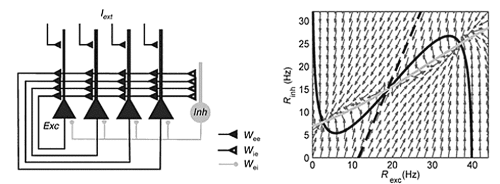Current Research
Highly data-driven models of neural computation and dynamics
To gain insight into the physiological, neuro-dynamical, and neuro-computational principles and mechanisms underlying behavior and cognition, we develop mathematical models of single neurons and networks. 'Highly data-driven' in this context means that parameters of these models are directly estimated from in-vitro and/or in-vivo electrophysiological data, often in statistically principled ways (e.g. maximum likelihood). Our focus is on brain structures like the prefrontal cortex or hippocampus which are involved in higher cognitive functions, such as rule learning, working memory, or decision making.
Application in psychiatric contexts
We use such models in an attempt to understand not only the healthy state, but also which aspects of networks dynamics may go aberrant in psychiatric conditions, which implications this may have for computational function and behavior, and how potentially 'healthy network dynamics' could be restored. We do this on the basis of neural network models estimated from relevant genetic and pharmacological animal models.
Statistical analysis of neural coding and dynamics
Recent advances in multiple single-unit recordings and neuroimaging enable to readdress some long-standing questions about the neural code, the language of the brain. Having simultaneous recordings from the activity of tens to hundreds of neurons, we develop new statistical tools to mine these data sets for spatio-temporal patterns representing environmental or cognitive events, and for reconstructing from these the underlying network dynamics. These statistical approaches complement our model-based analyses of healthy and aberrant network function.

Source: D. Durstewitz, Neural Networks (2009)

